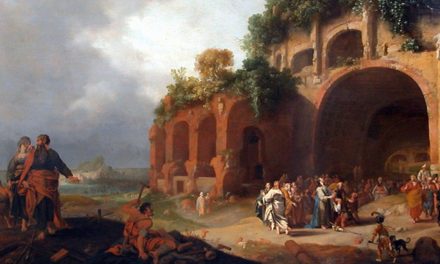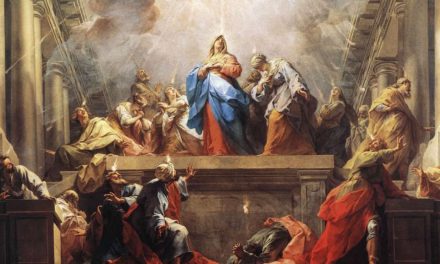Battle in the Desert — Jesus’ First Victory for the Kingdom
Editor’s Note — Part 3 of Jesus, Kingdom Builder, a 13-part study of St. Matthew’s Gospel by Dr. Sri. The series will run every other Friday.

Photography © by Andy Coan
In Matthew 4, we see that Jesus began His career with a very bold opening move.
Notice how Jesus did not start His public ministry by teaching in the synagogue or preaching in the streets. Nor did He begin by performing miraculous works such as healing the sick, walking on the water, or raising the dead. Rather, the very first thing Jesus chose to do was to confront the devil. And this is quite significant.
After His baptism in the Jordan River, Jesus traveled out into the desert to fast and pray for 40 days, and there He was tempted three times by Satan. What was the significance of this cryptic dual between the King of Kings and the prince of this world? In this famous scene, we will see how Jesus fights His first battle as the Messiah-King, but He does it in a way that might have caught many first-century Jews by surprise.
The Lion King
In Matthew 3, Jesus’ baptism marked the beginning of His messianic mission. There at the Jordan, the Spirit descended upon Him, just as the Spirit descended on Israel’s monarchs when they were anointed as kings. Jesus was thus identified as the “Anointed One” or “Messiah.”
But what did it mean to be the Messiah? What were Jews expecting the Messiah to do?
Israel’s kings were often associated with fighting Israel’s battles. The Jews thought that the sending of a Messiah-King would be part of God’s plan to restore Israel and free them from the pagan nations. This, after all, is what the great Israelite kings of old had done. For example, King David defeated Goliath and the Philistines. King Hezekiah turned away the Assyrian armies. King Josiah lost his life in a battle against the Egyptians. Judas Maccabeus established his dynasty by leading a guerrilla war-like campaign against the Syrians, driving their pagan idolatry out of the Temple and out of Jerusalem. As one can see, the great kings of Israel were known for protecting God’s people from the oppression of their pagan neighbors.
Looking to the future, the Psalms and the prophets foretold how God would send another great king to do the same. This heir would establish his dominion by triumphing over the pagan nations. From the fall of the Davidic monarchy (586 B.C.) to the time of Jesus, these scriptural texts fueled Jewish hopes for a renewed Davidic dynasty. God would send a new king who would free the Israelites from their enemies, reestablish Israel in the Promised Land, and bring blessing to the world (Ps. 2:8; 72:8-11, 17; 110:6; Is. 9:1-7; 11:1-10; Ezek. 34; Dan. 9).
A Holy War?
This certainly was good news for Jews in Jesus’ day. After centuries of foreign domination, they longed for the renewal of the Davidic dynasty and anxiously anticipated the coming of the great king who would liberate Israel.
Some Jews in the century before Jesus even put their hopes down on paper, writing texts of their own which described how God would send a king who would lead them into triumph over their enemies. They told stories about how this king would smash the gentiles like a potter’s jar crushed to pieces. The Messiah would come out of the forest like a lion to deliver the faithful Jews from the hands of the Romans. Indeed, this “holy war” theology surrounded many Jewish longings for the restoration of Israel.
But was this the type of liberation Jesus would offer?
A Surprise Attack
Like the great kings who went before Him, Jesus as the Messiah-King did enter into a battle of His own. But the type of battle Jesus came to fight was quite different from what many of His contemporaries were expecting. Instead of confronting the Romans — who were the evil oppressors of the Jews in Jesus’ day — Jesus marched into the desert to combat a much fiercer opponent: the devil.
The account in Matthew 4 of Jesus’ overcoming the three temptations of the devil would remind the careful reader that the real enemy of Israel was much bigger than the Roman Empire or any other pagan nation. The true enemy was the power of sin and Satan. This might have come as a surprise to a number of Jewish leaders who focused on resisting Rome and were anticipating a Messiah who would lead them in battle against their pagan oppressors.
However, by beginning His public ministry with a showdown against the devil, Jesus shows us what type of Messiah-King He will be. It is true that He was coming to start a revolution, but it was not a militaristic one. His revolution was internal, inside the hearts and minds of God’s people, freeing them from the bondage of sin.
Here Jesus is simply acting in accordance with what the Jewish law and prophets said about Israel’s situation in the first century. Israel’s suffering under foreign occupation was a symptom of a much deeper illness. Unfaithfulness to God brought on the exile and the fall of the Davidic monarchy. To focus on driving out the Romans would be to miss the point. As one New Testament scholar explains, “to drive out paganism with paganism’s weapons is already to lose the battle.”[1] Thus Jesus came not to fight the Romans, but to treat the root of the problem: the sin of Israel and the sin of all humanity. If sin is conquered, Israel will be truly free. And that is what Jesus sets out to do in the desert.
Desert Storm
As the Messiah-King, Jesus would have been viewed by His Jewish followers as their representative. Throughout Israel’s history, the king was considered an embodiment of the whole nation. So closely was the king associated with his people that what happened to the king could be said to have happened to the people as a whole. For example, when the king was faithful to the covenant with Yahweh, the entire nation received God’s blessings. But when the king sinned greatly, the whole nation suffered for his infidelity. The king represented the people.
This helps us to understand Jesus’ temptations in the desert. As Israel’s royal representative, Jesus experienced the same trials Israel did during the exodus. What happened to Israel in the time of Moses happened to Jesus in the first century.
The fact that Jesus spent 40 days in the desert shows how He symbolically relived the story of Israel’s 40 years in the wilderness during the exodus. Furthermore, upon closer examination of Jesus’ three temptations, we will see that Jesus faced the same trials Israel faced in the desert, entering into the drama of Israel’s weaknesses and failings during their pilgrimage to the Promised Land.[2]
But then Jesus gave that story a surprise ending. Instead of stumbling like the ancient people of God did, He proved Himself to be a faithful Israelite. Jesus remained faithful precisely where Israel had been unfaithful. As such, Jesus symbolically undoes the knot of Israel’s sin. In His battle with Satan in these three temptations, Jesus pre-enacts what He ultimately will do for Israel on the Cross: conquer sin and defeat the devil. This is the real battle Jesus fights and the real liberation which He offers.
Three Strikes, He’s Out
Let’s take a closer look at how the three temptations of Jesus relate to the first three major trials of Israel in the exodus. Here we will see that the failings of Israel are symbolically overcome by Jesus’ victory over the devil.
(1) Israel’s first test. The first of Israel’s trials involved hunger. After Moses parted the Red Sea and led the Israelites out of Egypt and into the desert, the people celebrated their newfound freedom. However, they soon faced another problem: How would they find food in this desert? Their rejoicing quickly turned into panic. Instead of trusting in God to provide, the people turned against Moses, saying “You have brought us out into this wilderness to kill this whole assembly with hunger” (Ex. 16:3).
Jesus’ first test. Similarly, Jesus faced hunger in His first temptation as the devil tried to get Him to use His The Father sent the Spirit to lead Jesus into the desert to pray and fast for 40 days. For Jesus to turn the stones into bread would be to exercise His messianic authority for His own self-interest and thus depart from the Father’s will. Unlike Israel, who doubted that God would provide for their needs in the wilderness, Jesus does not waver from trusting the Father. He quotes Deut. 8:3 (a passage that brings to mind the story of Israel’s first test), saying “man does not live by bread alone” (Mt. 4:4). As the people’s royal representative, Jesus overcomes the first major fall of Israel in the desert.
Passing the Test
(2) Israel’s second test. The second trial involved Israel’s putting God “to the test.” After God provided for Israel’s nourishment by sending them bread from heaven (manna), the people soon faced another dilemma: How were they going to find water to drink in the dry desert? Once again, instead of putting their trust in Yahweh to provide for their needs, they doubted Him and accused Moses of orchestrating a vicious plot against them: “Why did you bring us up out of Egypt, to kill us and our children and our cattle with thirst?” (Ex. 17:3). God responded by giving them water from a rock, and He named the place of this second ordeal “Massah” which means “place of testing.” There, the people unjustly tested God’s trustworthiness, which is absolute and would not be questioned by the truly faithful Israelite.
Jesus’ second test. This corresponds to Jesus’ second temptation, when the devil challenged Him to throw Himself down from the pinnacle of the Temple to check if God’s angels would really save Him. Satan said to Jesus, “If you are the Son of God, throw yourself down, for it is written, ‘He will give his angels charge of you’” (Mt. 4:6). Unlike the Israelites at Massah, Jesus refused to test God on this or any other issue. Jesus had absolute confidence in the Father and had no desire to test Him. This is why He viewed this second temptation as parallel to Israel’s second trial in the desert. He responds to the devil by quoting part of Deut. 6:16. When we consider the verse as a whole, we see that Jesus had Israel’s second testing at Massah in mind: “You shall not put the Lord your God to the test, as you tested him at Massah” (Deut. 6:16). As such, Jesus overcomes Israel’s second failing by refusing to test God in this second temptation.
(3) Israel’s third test. The last temptation of Israel involved worshipping a false god. This came in the golden calf episode at Mount Sinai. After Moses left the people to go up the mountain for 40 days and receive the Ten Commandments, the people down below did not know what happened to their leader and feared he had died. Failing to trust Yahweh again, they built an idol in the shape of a golden calf, putting their trust in an Egyptian pagan deity.
Jesus’ third test. Similarly, in the third test, Satan tempted Jesus to worship him in exchange for all the kingdoms of the world. Jesus refused to worship a false god and responded by alluding to Deut. 6:14, saying “You shall worship the Lord your God and him only shall you serve” (Mt. 4:10). In this third temptation, Jesus overcomes Israel’s sin of idolatry.
The Victory of Jesus
As the first act of His messiahship, Jesus’ victory over the devil sets the tone for the rest of His public ministry. Most of Jesus’ subsequent actions — whether His healings, His forgiving people’s sins, or His exorcisms — can be seen as repercussions of His initial triumph over the devil in the desert. Jesus will go from town to town carrying out His victory in the lives of the people He meets. In touching the lives of the sick, the crippled, the blind, or the great sinners and demoniacs, Jesus frees them from the power and effects of sin, so that they may experience God’s victory in their own lives. All this, of course, points forward to Jesus’ work on the Cross, where He definitively conquers the prince of this world and wins salvation for all humanity (cf. Jn. 12:31).
The Church’s annual celebration of Lent helps us experience the victory of Jesus in our own lives today. In the 40 days of Lent, Christians participate in Jesus’ 40 days of prayer, fasting, and trial in the desert. Through our prayer and mortification, we too prepare to battle sin. But the question we must ask ourselves this Lent is whether we will be like Israel in the desert, failing to put our trust in God, or like Jesus, faithful to Our Heavenly Father, so that we may experience the abundant blessings of the victory of Jesus on Easter Sunday.
Footnotes:
[1] N.T. Wright, Jesus: The New Way (Worcester, MA: Christian History Institute, 1998), 52.
[2] Cf. J. Kingsbury, Matthew as Story (Philadelphia: Fortress Press).
Questions for Discussion:
- Read John 12:31. How is Jesus’ victory in the desert important for understanding His work on the Cross?
- We saw how Israel did not trust in God to provide for their needs, and thus they fell three times in the desert. But Jesus’ full confidence in the Father allowed Him to resist the three temptations of the devil. What are the areas in our own lives where we might lack trust in God? How can we become more like Jesus, confidently placing our lives in the Father’s hands?
- The Church’s annual celebration of Lent helps us experience the victory of Jesus in our own lives today. What specifically can we do this Lent to combat sin in our own lives and in the world?
Acknowledgement:
Reprinted with permission from the March 1999 issue of Lay Witness magazine. © 1999 Catholics United for the Faith / www.cuf.org/Laywitness/index.asp
We value your comments and encourage you to leave your thoughts below. Please share this article with others in your network. Thank you! – The Editors













